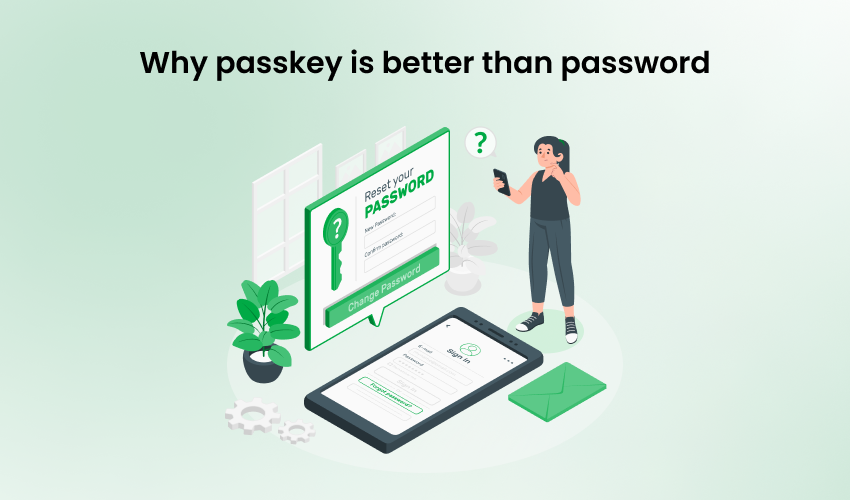 December 10, 2023
December 10, 2023
why passkey is better than a password?
Whenever you visit a site, the first thing that comes to mind is, how secure is it? Especially a banking website, where your sensitive information is stored. Times have changed, and technology has evolved for the Better Than a Password.
Passwords may soon be a thing of the past, as Passkey is the new buzzword in technology. Brands like Google and Amazon have adopted the technology and see it as a positive change related to security.
Google takes online security seriously, and the company announced an official switch to passkeys recently. Also, Google announced several noteworthy benefits of using the passkey such as immunity from phishing attempts, easy log-in, and support for biometric authentication.
The company noticed users are enjoying faster log-in attempts with passkeys. Data published by Google clocked an average log-in time of 30.4 with passwords and 14.9 with passkeys, which makes it clear that passkeys take less time to log in apart from being secure.
Besides, who would not want their information to be secure on a website? Security concerns have caused inconvenience over the years and affected the company’s goodwill. Using passkeys as an alternative to passwords can reduce security vulnerabilities associated with data breaches.
Recent research shows that 70% of people get stressed because they don’t remember passwords. With passkeys, there is no stress about remembering the password, as you can access the site with a fingerprint, PIN, or face scan.
A passkey is a transformational step towards better digital security. Let’s dive deeper into the topic to understand what is a passkey and whether it’s better than a password.
What is Passkey?
Passkeys are the best alternatives to passwords, as it is no hassle to remember the user credentials. With passkeys, you can sign in to a site or an app using a unique biometric sensor, such as a face scan or fingerprint.
Plus, you can use a PIN or pattern similar to a phone lock system. Ideally, you can select an account to sign in, and a password is not required. Authentication is based on the device’s screen lock, leading to total security.
After creating a passkey, the user can switch to a new device and use it without registering it again. The best part is that it doesn’t rely on traditional biometric authorization. Meaning, you don’t have to reset it on each device to log in, which saves time. With passkeys, you can achieve multifactor authentication in a single step.
So, you can replace both the OTP and password for enhanced protection against phishing attacks. With standardized features, a single implementation can enable a passwordless experience across all devices and different operating systems.
How do Passkeys work?
Passkeys use an asymmetric encryption system that helps verify a user’s identity. The service provider generates a public key and shares it with the user.
However, the private key is stored on the user’s device. When there is a need for authentication, the server provider uses the public key to encrypt the request, while the user decrypts it using the private key.
The best part is that passkeys are not vulnerable to common phishing attacks and password reuse, making them secure. Essentially, there is no weak passkey, as everything is secure.
If cybercriminals breach your public key, it will be useless for them without the private key information. Besides a seamless authentication experience, passkeys provide efficient usability.
With passkeys, users don’t have to remember complex passwords. Also, passkeys don’t rely on servers as passwords do, which reduces the burden on servers for data storage. Hence, they are less vulnerable to large-scale threats and data breaches.
Types of Passkeys
Passkeys are available in two primary versions but can differ in functional purposes.
- Device-bound Passkey
Device-bound passkey is also known as an enterprise passkey and has strong functional features. Plus, it operates in a tech stack covering the entire range of enterprises.
Device-bound passkeys are safe compared to other versions available, and companies trust the passkey for their sensitive data protection.
- Multi-device Passkey
These passkeys are meant for individual use, not enterprise use. Plus, they are limited in security features and functionality, unlike device-bound
You cannot use the passkey for desktop logins, and they do not meet standard regulatory requirements for independent possession. Also, they lack other critical enterprise features for safety. You can use a multi-device passkey for mobile phones or laptops.
why passkey is better than a password?
The most important reason to use a passkey is that it provides better safety than a password. The technology can protect users from phishing attacks. As it works on registered apps and sites, it can’t trick users into authenticating on a fake website because the operating system handles the verification part.
In addition, developers may save only the public key to the server instead of a password. Plus, it reduces the chance of hackers hacking into the servers, so there is less cleanup in case of a breach.
Passkeys reduce SMS costs, making them a cost-effective alternative for two-factor authentication. Also, it shares no secret information, as sensitive data from the passkey will never leave your device.
The sensitive information on your phone is stored using a special chip that even security agencies may not crack. Passkeys are better for the user experience as they require biometric system validation.
Instead of typing complex passwords, users can log in in seconds with the feature. The login input box will know that your device has a passkey for the domain.
Advantages of Passkeys
Passkeys are complex, and using the technology involves a biometric system, making it tricky. Simply put, passkeys are more tricky to attack than passwords.
Each passkey is different and linked to the user’s device using a cryptographic pair, making it difficult for hackers to gain unauthorized access without physical device possession. Other advantages of a passkey are:
- Passwordless authentication can improve cybersecurity issues. The absence of passwords eliminates the need for companies to manage password storage and regulatory requirements.
- With passkeys, you don’t have to manage things manually. Essentially, you can generate an account and request that your authenticator provide a public or private key on your behalf.
- More so, passkeys are future-proof as they are slowly replacing passwords. You can future-proof your online security by avoiding passwords, as different security threats evolve.
- User convenience is another advantage of using a passkey as you don’t have to remember long passwords for login, so it cuts down on time.
- Besides, you can use passkeys for signing digital documents or encrypting emails for added security.
- Passwordless authentication lowers the long-term costs.
Disadvantages of Passkeys
Every new technology has pros and cons, and Passkey isn’t an exception. Some of the drawbacks of Passkey can be described as follows:
- It’s an unfamiliar technology for most companies, so integrating and adopting it may be tricky.
- Users or companies may need to learn how to use the technology to adjust to new authentication processes, which is frustrating. Simply put, a passkey has a steeper learning curve than a password.
- Also, you may face biometric issues while using passkeys or verifying the account. For instance, to use the fingerprint, users need to ensure their fingers are clean. A similar thing applies to faces as well.
- Also, it can be tricky for disabled users, and older devices may not support the new updates in passkey technology.
- Some sites or apps may not support Passkey, making it ineffective.
- Some devices are cheap, while others cost hundreds of dollars, which may be expensive for some users.
- Compared to passwords, passkeys are tricky to set up because they involve hardware and software.
- Lastly, passkeys are expensive as they require separate user devices.
Password vs. Passkey
It’s essential to understand the differences between passwords and passkeys to know which one is better. Passkeys use the biometric system, and you can generate them using cryptographic techniques. You can generate passwords manually, as they’re user-generated.
Passkeys provide better protection against phishing attacks, while passwords are vulnerable to phishing attacks. You can’t store passkeys on servers, but you can store passwords on servers, which is a point of difference.
Most companies store passwords in hashed and salted form. Passkeys don’t have universal appeal, and there is no support across all the platforms and browsers.
Passwords have support across all platforms and browsers, making them universally applicable. Passkeys are complex to understand, but the password technique is simple. Moreover, Passkeys rely on the security and availability of the device, whereas passwords rely on the user’s device.
If a passkey is lost, the recovery process may take time; it is a complex process. However, recovering a password is easy and hassle-free. Passkeys are the future of authentication, and passwords have universal appeal.
Companies that are already using Passkey
Passkeys are the safer alternative to passwords, and realizing this, many companies have adopted and integrated them with their technology. From healthcare to finance and eCommerce, most sectors have integrated with passkeys.
After all, who wouldn’t want to enhance security measures while simplifying user access? Brands like Google, Shopify, PayPal, Adobe, Amazon, and Bayer have successfully integrated with the passkey technology.
Google recently rolled out passkey authentication for enhanced security updates as there are many Iot security challenges that are faced by business owners. To overcome this many companies have taken a step towards a passwordless future. Also, passkeys for Google accounts are now available, providing security to end users.
For Google Workplace accounts, admins will soon have the option of using passkeys. As the technology is still in the integration process, it will take time to reach the end users. But the future looks bright with enhanced security updates.
Passkeys for eCommerce sites like Amazon can provide safety and security to shoppers. They eliminate the need for passwords by letting users verify their identity with biometrics, patterns, or a PIN. For users who choose passkeys, it can replace the SMS code entry that eCommerce shops often ask for.
Top Three Considerations for Passkey Implementation:
Depending on the applications or website, there is no single way to implement a passkey, but these considerations are significant.
1. Risk tolerance
There is a difference in user case and risk tolerance. You’ll have to decide regarding vulnerability spots and where you want to offer flexibility for users. Once you know about risk tolerance, you can implement passkeys across different devices.
2. User persona
You need to configure passkeys for use cases for actual implementation. Better still, consider your user’s device preference and operating systems. These preferences can impact configuration and passkey implementation.
3. Track the roadmap
Technology is updated daily, and you can chart your roadmap following these updates. Simply put, passkey providers may update their ecosystem compatibility or release new devices with biometric support. These changes can impact passkey implementation. Though change is always good, you will have to track these changes.
Wrapping up
Though passwords are the current means for sign-in, they are not completely secure. That is why it’s essential to find other ways to secure the data and information.
Passkey is a revolution in the field of passwordless security. Besides, passkeys use strong encryption algorithms, which safeguard the data and information against cyberattacks.
Finally, companies won’t push for passkeys on sites but can consider them a safer option in the future. All this makes Passkey a more popular option than passwords.







